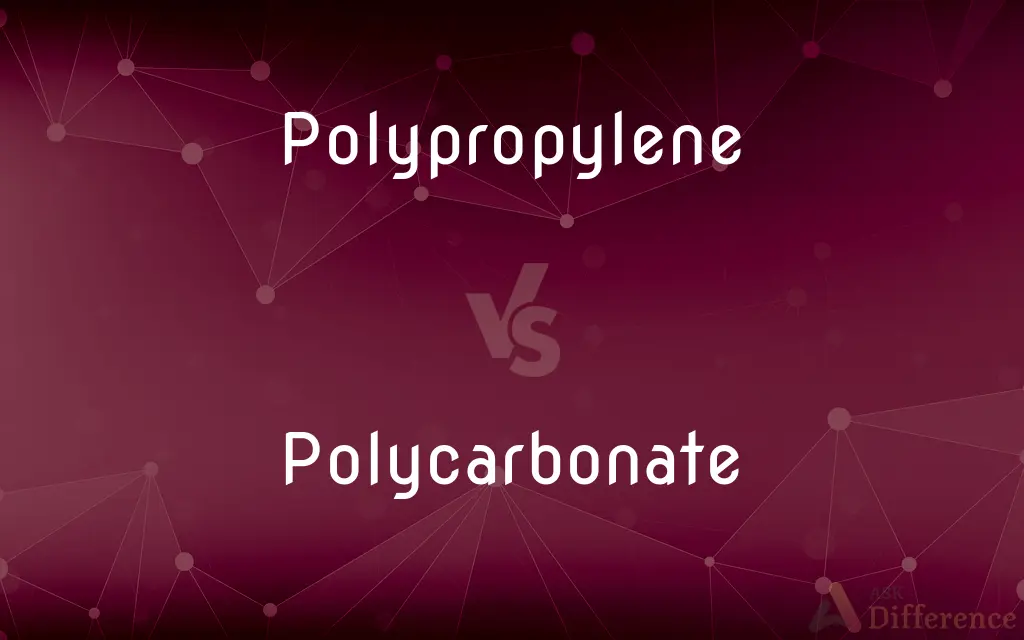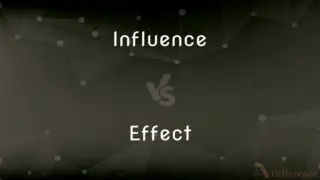Polypropylene vs. Polycarbonate — What's the Difference?
By Urooj Arif & Fiza Rafique — Updated on March 20, 2024
Polypropylene is thermoplastic polymer known for its toughness and resistance to chemicals, widely used in packaging and textiles. Polycarbonate is a durable, transparent material with high impact resistance, commonly used in eyewear and safety equipment.

Difference Between Polypropylene and Polycarbonate
Table of Contents
ADVERTISEMENT
Key Differences
Polypropylene (PP) is a versatile thermoplastic polymer used extensively in various industries due to its resistance to chemicals, water, and electricity. It's lightweight and has a high melting point, making it ideal for food containers, automotive parts, and textiles. Polycarbonate (PC) is recognized for its outstanding strength, optical clarity, and temperature resistance, which makes it suitable for applications requiring transparency and durability, such as bulletproof glass, eyewear lenses, and electronic devices.
While polypropylene is known for its flexibility and fatigue resistance, making it perfect for living hinges in containers, polycarbonate boasts exceptional impact resistance and is often used in situations where safety is paramount, like in helmets and protective gear. The difference in mechanical properties underlines the distinct uses of PP and PC in various applications.
In terms of processing, polypropylene can be easily molded using injection molding techniques and is known for its low-cost production. Polycarbonate, while also moldable, requires higher processing temperatures and offers a different set of characteristics, including transparency and flame retardancy, making it more suitable for electrical and optical applications.
Environmental considerations also play a role; polypropylene is more readily recyclable and less prone to leaching, making it a common choice for food containers and packaging. Polycarbonate, although recyclable, has raised concerns due to the presence of bisphenol A (BPA) in certain applications, prompting the development of BPA-free variants for consumer safety.
Despite their differences, both polypropylene and polycarbonate offer unique advantages, such as polypropylene's resistance to chemical wear and polycarbonate's ability to withstand high-impact forces, making them indispensable in their respective fields.
ADVERTISEMENT
Comparison Chart
Chemical Structure
Propylene monomer polymerization
Bisphenol A and phosgene polymerization
Key Properties
Chemical resistance, fatigue resistance
High impact resistance, optical clarity
Common Uses
Packaging, textiles, automotive components
Eyewear, safety equipment, electronic cases
Processing
Injection molding, low processing costs
Injection molding, higher processing temperatures
Environmental Impact
Recyclable, low leaching
Recyclable, concerns over BPA content
Temperature Resistance
High melting point, suitable for hot fill
Excellent temperature resistance, flame retardant
Transparency
Opaque
Transparent
Durability
Resistant to chemical wear
Resistant to physical impact
Compare with Definitions
Polypropylene
A thermoplastic polymer made from propylene monomer.
The reusable water bottle is made of polypropylene.
Polycarbonate
A durable, transparent thermoplastic.
The smartphone screen protector is made from polycarbonate.
Polypropylene
Used in the automotive industry for parts.
The car's bumper is crafted from durable polypropylene.
Polycarbonate
Known for its high impact resistance.
Polycarbonate is used in the production of bulletproof glass.
Polypropylene
Common in textiles and consumer goods.
The rugged outdoor rug is woven from polypropylene fibers.
Polycarbonate
Commonly used in safety equipment.
The construction helmet is reinforced with polycarbonate for added safety.
Polypropylene
Known for resistance to chemicals and fatigue.
Polypropylene containers are ideal for storing cleaning agents.
Polycarbonate
Suitable for optical applications due to clarity.
Prescription eyeglasses often use polycarbonate lenses for durability.
Polypropylene
Recyclable and environmentally friendly.
The polypropylene packaging can be recycled after use.
Polycarbonate
Can contain BPA, leading to safety considerations.
Food storage containers now use BPA-free polycarbonate.
Polypropylene
Polypropylene (PP), also known as polypropene, is a thermoplastic polymer used in a wide variety of applications. It is produced via chain-growth polymerization from the monomer propylene.
Polycarbonate
Polycarbonates (PC) are a group of thermoplastic polymers containing carbonate groups in their chemical structures. Polycarbonates used in engineering are strong, tough materials, and some grades are optically transparent.
Polypropylene
A synthetic resin which is a polymer of propylene, used chiefly for films, fibres, or moulding materials
High-impact polypropylene
Polypropylene underwear
Polycarbonate
Any of a group of thermoplastics that are linear polyesters of carbonic acid, especially those derived from bisphenol A and phosgene, characterized by high-impact strength, light weight, and flexibility, and used as shatter-resistant substitutes for glass.
Polypropylene
Any of various thermoplastic polymers of propylene. They are hard and tough, and are used to make molded articles and fibers.
Polycarbonate
(chemistry) Any of a range of polymers of aromatic carbonates; they are used to make light, flexible alternatives to glass. Abbreviation: PC
Polypropylene
A fabric of fibers made from any of these polymers.
Polypropylene
A thermoplastic resin made by the polymerization of propylene, and used for films, fibres, or moulding materials. Also known as polypropene.
Polypropylene
A polymer of propylene used as a thermoplastic molding material
Common Curiosities
Is polypropylene safe for food storage?
Yes, polypropylene is widely considered safe for food storage due to its chemical resistance and low leaching potential.
Can polypropylene be used at high temperatures?
Polypropylene has a high melting point, making it suitable for applications involving hot fill processes.
Are both polypropylene and polycarbonate recyclable?
Yes, both materials are recyclable, but recycling processes and facilities may vary in their ability to handle them.
Why is polycarbonate used in bulletproof glass?
Polycarbonate's high impact resistance makes it an ideal material for bulletproof glass and other protective applications.
Is polypropylene flexible?
Polypropylene is known for its flexibility and is often used in applications requiring durable, flexible materials, such as living hinges.
How does the presence of BPA in polycarbonate affect its use?
Due to health concerns associated with BPA, many manufacturers now offer BPA-free polycarbonate options, especially for food contact and consumer products.
What makes polycarbonate suitable for eyewear?
Its optical clarity and impact resistance make polycarbonate an ideal material for safety glasses and prescription lenses.
How are polypropylene and polycarbonate processed?
Both can be processed through injection molding, though polycarbonate typically requires higher temperatures.
Can polypropylene be used in outdoor applications?
While polypropylene can be used outdoors, it may require UV stabilization to maintain its properties under sunlight.
What are the main differences in the appearance of polypropylene and polycarbonate?
Polypropylene is typically opaque, while polycarbonate is known for its clear, transparent quality.
Can polypropylene withstand freezing temperatures?
Polypropylene maintains its properties in a wide temperature range, including freezing conditions.
Can polycarbonate protect against UV rays?
Polycarbonate can be treated with UV stabilizers to protect against UV rays, making it suitable for outdoor applications.
Are there any environmental concerns with using polycarbonate?
The primary environmental concern with polycarbonate is its BPA content, though BPA-free options are increasingly available.
How does the cost of polypropylene compare to polycarbonate?
Polypropylene is generally less expensive than polycarbonate, reflecting differences in their properties and processing requirements.
Is polycarbonate fire resistant?
Polycarbonate is inherently flame retardant and can be enhanced with fire-resistant additives for specific applications.
Share Your Discovery

Previous Comparison
Copy vs. Issue
Next Comparison
Influence vs. EffectAuthor Spotlight
Written by
Urooj ArifUrooj is a skilled content writer at Ask Difference, known for her exceptional ability to simplify complex topics into engaging and informative content. With a passion for research and a flair for clear, concise writing, she consistently delivers articles that resonate with our diverse audience.
Co-written by
Fiza RafiqueFiza Rafique is a skilled content writer at AskDifference.com, where she meticulously refines and enhances written pieces. Drawing from her vast editorial expertise, Fiza ensures clarity, accuracy, and precision in every article. Passionate about language, she continually seeks to elevate the quality of content for readers worldwide.
















































